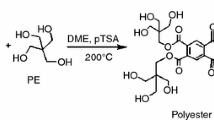Abstract
A hyperbranched polyol (HBP) was synthesized using dipentaerythritol as a core material and 2,2-bis(methylol) propionic acid as a chain extender. This was reacted with varying concentrations of soya fatty acid to make hyperbranched alkyd (HBA) resins. The HBA resins containing unreacted hydroxyl groups were reacted with isophorone diisocyanate at NCO/OH ratio of 1.6:1 to make high solid hyperbranched urethane alkyd (HBUA) resins. The excess NCO content in the HBUA resins was used to cure with atmospheric moisture, and thus moisture-cured HBUA coatings were formed. The resins were characterized by FTIR, and 13C NMR spectroscopic analysis. A series of such resins were made using different fatty acid/isocyanate ratios with respect to the hydroxyl groups present in the HBP. The effect of compositions on the mechanical and weathering properties of the cured resins was investigated. It was observed that there was an optimum fatty acid–isocyanate ratio in terms of the requirements of solvent, mechanical and weathering properties of the resin. The requirement of solvents for formulating HBUA coatings is much lower compared to linear alkyd-based coatings. The present study reveals that the moisture-cured HBUA resins can be used as a binder material in the field of low-pollution weather-resistance coatings.








Similar content being viewed by others
References
Weiss, KD, “Paints and Coatings: A Mature Industry in Transition.” Prog. Polym. Sci., 22 203–245 (1997)
Lindeboom, J, “Air-Drying High Solids Alkyd Paints for Decorative Coatings.” Prog. Org. Coat., 34 147–151 (1998)
Manczyk, K, Szewczyk, P, “Highly Branched High Solid Alkyd Resins.” Prog. Org. Coat., 44 99–109 (2002)
Zabel, KH, Klaassen, RP, Muizebelt, WJ, Gracey, BP, Hallett, C, “Design and Incorporation of Reactive Diluents for Air-Drying High Solids Alkyd Paints.” Prog. Org. Coat., 35 255–264 (1999)
Johansson, M, Glauser, T, Jansson, A, Hult, A, Malmström, E, Claesson, H, “Design of Coating Resins by Changing the Macromolecular Architecture: Solid and Liquid Coating Systems.” Prog. Org. Coat., 48 194–200 (2003)
Asif, A, Shi, W, “Synthesis and Properties of UV Curable Waterborne Hyperbranched Aliphatic Polyester.” Eur. Polym. J., 39 933–938 (2003)
Staring, E, Dias, AA, Van Bentham, RA, “New Challenges for R&D in Coating Resins.” Prog. Org. Coat., 45 101–117 (2002)
Desimone, JM, “Branching Out into New Polymer Markets.” Science, 269 1060–1061 (1995)
Morikaw, A, Kakimoto, M, Imani, Y, “Synthesis and Characterization of New Polysiloxane Starburst Polymers.” Macromolecules, 24 3469–3474 (1991)
Deka, H, Karak, N, “Bio-based Hyperbranched Polyurethanes for Surface Coating Applications.” Prog. Org. Coat., 66 192–198 (2009)
Jansen, JF, “Dendrimer and an Active Substance Occluded in the Dendrimer, a Process for the Preparation Thereof and a Process for Releasing the Active Substance.” US 5788989, 1997
Milco, LA, “Dendritic Polymer Coatings.” US 5731095, 1998
Jayakannan, M, Van Dongen, J, Behera, L, Ramakrishan, S, “SEC-MALDI-TOF Mass Spectral Characterization of a Hyperbranched Polyether Prepared Via Melt Transetherification.” J. Polym. Sci. A Polym. Chem., 40 4463–4476 (2002)
Voit, B, “New Developments in Hyperbranched Polymers.” J. Polym. Sci. A Polym. Chem., 38 2505–2525 (2000)
Billmayer, FW, Text Book of Polymer Science, 3rd ed. Wiley, New York, 1984
Sasihar, K, Narayan, R, Raju, KVSN, “Development of Moisture Cure Polyurethane–Urea Coatings Using 1,2,3-Triazole Core Hyperbranched Polyesters.” J. Coat. Technol. Res., 10 609–619 (2013)
Bat, E, Gunduz, G, Kasakurek, D, Akhmedov, IM, “Synthesis and Characterization of Hyperbranched and Air Drying Fatty Acid Based Resins.” Prog. Org. Coat., 55 330–336 (2006)
Pettersson, B, “Hyperbranched Polymers: Unique Design Tools for Multi-property Control in Resins and Coatings.” Pigment Resin Technol., 25 408–414 (1996)
Kanai, T, Mahato, TK, Kumar, D, “Synthesis and Characterization of Novel Silicone Acrylate–Soya Alkyd Resin as Binder for Long Life Exterior Coatings.” Prog. Org. Coat., 58 259–264 (2007)
Satos, D, Brites, C, Costa, MR, Satos, MT, “Performance of Paint Systems with Polyurethane Topcoats, Proposed for Atmospheres with Very High Corrosivity Category.” Prog. Org. Coat., 54 344–352 (2005)
Zhou, S, Wu, L, Sun, J, Shen, W, “The Change of the Properties of Acrylic-Based Polyurethane Via Addition of Nano-silica.” Prog. Org. Coat., 45 33–42 (2002)
Nasar, AS, Jikei, M, Kakimoto, MA, “Synthesis and Properties of Polyurethane Elastomers Cross Linked with Amine-Terminated AB2-type Hyperbranched Polyamides.” Eur. Polym. J., 39 1201–1208 (2003)
Xu, G, Shi, W, “Synthesis and Characterization of Hyperbranched Polyurethane Acrylates Used as UV Curable Oligomers for Coatings.” Prog. Org. Coat., 52 110–117 (2005)
Rannard, SP, Davis, NJ, Herbert, I, “Synthesis of Water Soluble Hyperbranched Polyurethanes Using Selective Activation of AB2 Monomers.” Macromolecules, 37 9418–9430 (2004)
Jena, K, Chattopadhyay, DK, Raju, KVSN, “Synthesis and Characterization of Hyperbranched Polyurethane–Urea Coatings.” Eur. Polym. J., 43 1825–1837 (2007)
Patel, A, Patel, C, Patel, MG, Patel, M, Dighe, A, “Fatty Acid Modified Polyurethane Dispersion for Surface Coatings: Effect of Fatty Acid Content and Ionic Content.” Prog. Org. Coat., 67 255–263 (2010)
Chattopadhyay, D, Raju, KVSN, “Structural Engineering of Polyurethane Coatings for High Performance Applications.” Prog. Polym. Sci., 32 352–408 (2007)
Kumari, S, Mishra, AK, Chattopadhyay, DK, Raju, KVSN, “Synthesis and Characterization of Hyperbranched Polyesters and Polyurethane Coatings.” J. Polym. Sci. A Polym. Chem., 45 2673–2688 (2007)
Briscoe, B, Luckham, P, Zhu, S, “The Effects of Hydrogen Bonding upon the Viscosity of Aqueous Poly(vinyl alcohol) Solutions.” Polymer, 41 3851–3860 (2000)
Patel, VC, Varughese, J, Krishnamurthy, PA, Jain, RC, Singh, AK, Ramamoorty, M, “Synthesis of Alkyd Resin from Jatropha and Rapeseed Oils and Their Applications in Electrical Insulation.” J. Appl. Polym. Sci., 107 1724 (2008)
Chen, A, Yao, C, Zeng, S, Yi, C, Xu, Z, “Preparation and Properties of Hyperbranched Polyurethanes Via Oligomeric A2 + bB2 Approach.” Polym. Bull., 61 363–371 (2008)
Acknowledgments
The authors would like to thank Dr. S.K. Singh of NMRL for providing guidance and encouragement during the work.
Author information
Authors and Affiliations
Corresponding author
Rights and permissions
About this article
Cite this article
Naik, R.B., Malvankar, N.G., Mahato, T.K. et al. Novel moisture-cured hyperbranched urethane alkyd resin for coating application. J Coat Technol Res 11, 575–586 (2014). https://doi.org/10.1007/s11998-013-9561-8
Published:
Issue Date:
DOI: https://doi.org/10.1007/s11998-013-9561-8




